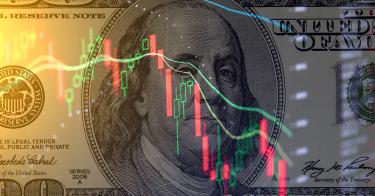The last time inflation was this high, interest rates climbed over 19 percent. Chairman Paul Volcker and the Federal Reserve took a lot of political heat for the high rates, but the Fed’s response brought down inflation. Theory and experience have shown that active monetary policy can keep inflation in check. But to tame the current inflation without a repeat of the early 1980s, Congress will need to adjust fiscal policy to work with the Fed.
Inflation is well above the Fed’s 2 percent target. The most recent reading of the Personal Consumption Expenditures Price Index, the Fed’s preferred measure, showed a 6.8 percent increase over the past year, with a 1.0 percent increase in just the last month.
High inflation is a natural result of excessive deficit spending and money printing. Congress spent trillions of dollars on pandemic-related programs, and the Fed covered that by issuing new money. Of the $6.7 trillion in new federal debt held by the public since the end of 2019, $3.6 trillion is now held by the Federal Reserve.
The Fed has responded to rising inflation by winding down its asset purchases and raising interest rates. We’re already seeing the effects of the Fed’s rate hikes in two quarters of negative real GDP growth. If lawmakers leave the Fed to do all the work, it will require larger interest rate increases that will put the brakes on economic growth.
But the problem is bigger than just the next turn in the business cycle. The Fed can hold inflation down only temporarily if Congress insists on spending more than it takes in. Debt held by the public is now 98 percent of GDP. The Congressional Budget Office (CBO) expects debt to climb to 185 percent by 2052 as outlays grow faster than GDP.
Eventually, the market will believe that Congress will never run the surpluses needed to pay back the debt, leading either to crushing interest rates, outright default or the Fed needing to inflate the debt away. If Congress wants 2 percent inflation, it must run deficits consistent with that goal.
Senate Democrats have proposed the Inflation Reduction Act (IRA) as their way to bring down inflation. The bill establishes a corporate minimum income tax and a new excise tax on drug manufacturers. It also increases tax enforcement through the IRS. About half the new revenues are spent on subsidies for climate change and ObamaCare. Tax revenue over the next 10 years would go up about 1.3 percent, while spending would increase by about 0.5 percent, based on CBO figures.
Yet, despite the bill’s name, multiple experts predict that the law will have no effect on inflation. The Penn Wharton Budget Model estimates that the effect on inflation will be statistically indistinguishable from zero. Moody’s estimates the law will reduce the Consumer Price Index by 0.33 percent nine years from now—an average reduction in the inflation rate of 0.03 percent. The CBO says it might lower the inflation rate by as much as 0.1 percent—or raise it by the same amount.
>>> Inflation Reduction Act Shows Far Left’s Extremism and Elitism
This is because of the inherent contradictions in the bill. It reduces the deficit, which should reduce inflation by reducing the need to print money. However, it reduces the deficit by raising taxes instead of cutting spending. That discourages production and leads to higher prices, counteracting the deflationary effect of a smaller deficit. Reducing government spending would reduce final demand, reinforcing the bill’s deflationary effects. For maximum effectiveness, the IRA should cut spending.
If the bill were serious about reducing inflation, all its provisions would either increase taxes or reduce spending. However, about half the tax revenue projected to be raised is used to finance additional spending on items from the Green New Deal agenda.
The Fed has raised rates by 75 basis points over its last two meetings, but Congress can’t sit back and expect the Fed to do all the work. High interest rates with large deficits will lead to explosive growth in debt. The Inflation Reduction Act fails to live up to its name and does nothing to address the excessive spending that is driving the federal government’s structural deficit.
This piece originally appeared in The Hill on 08/08/2022




